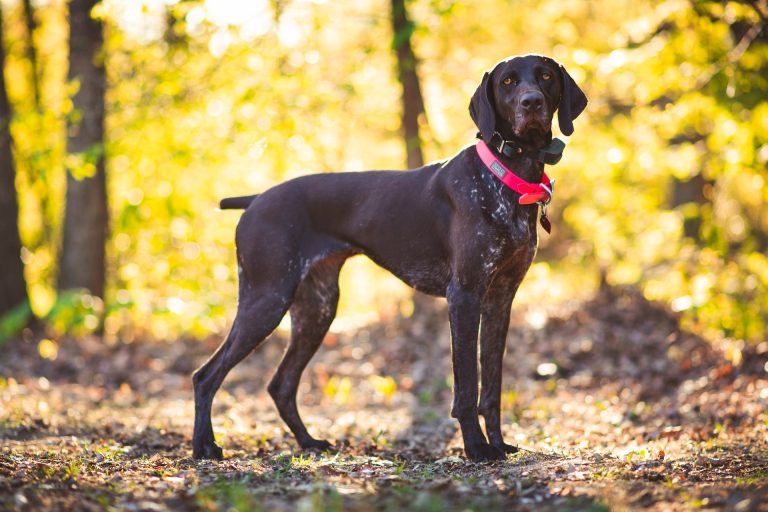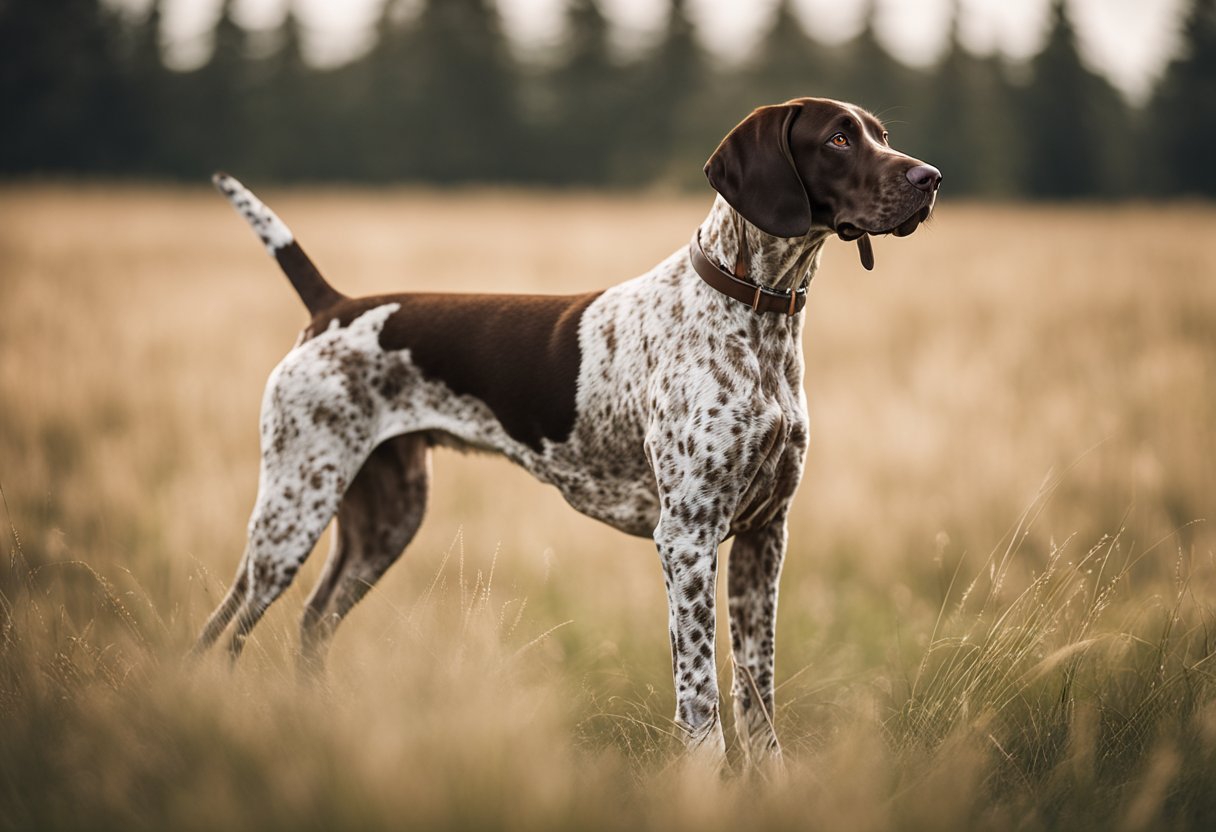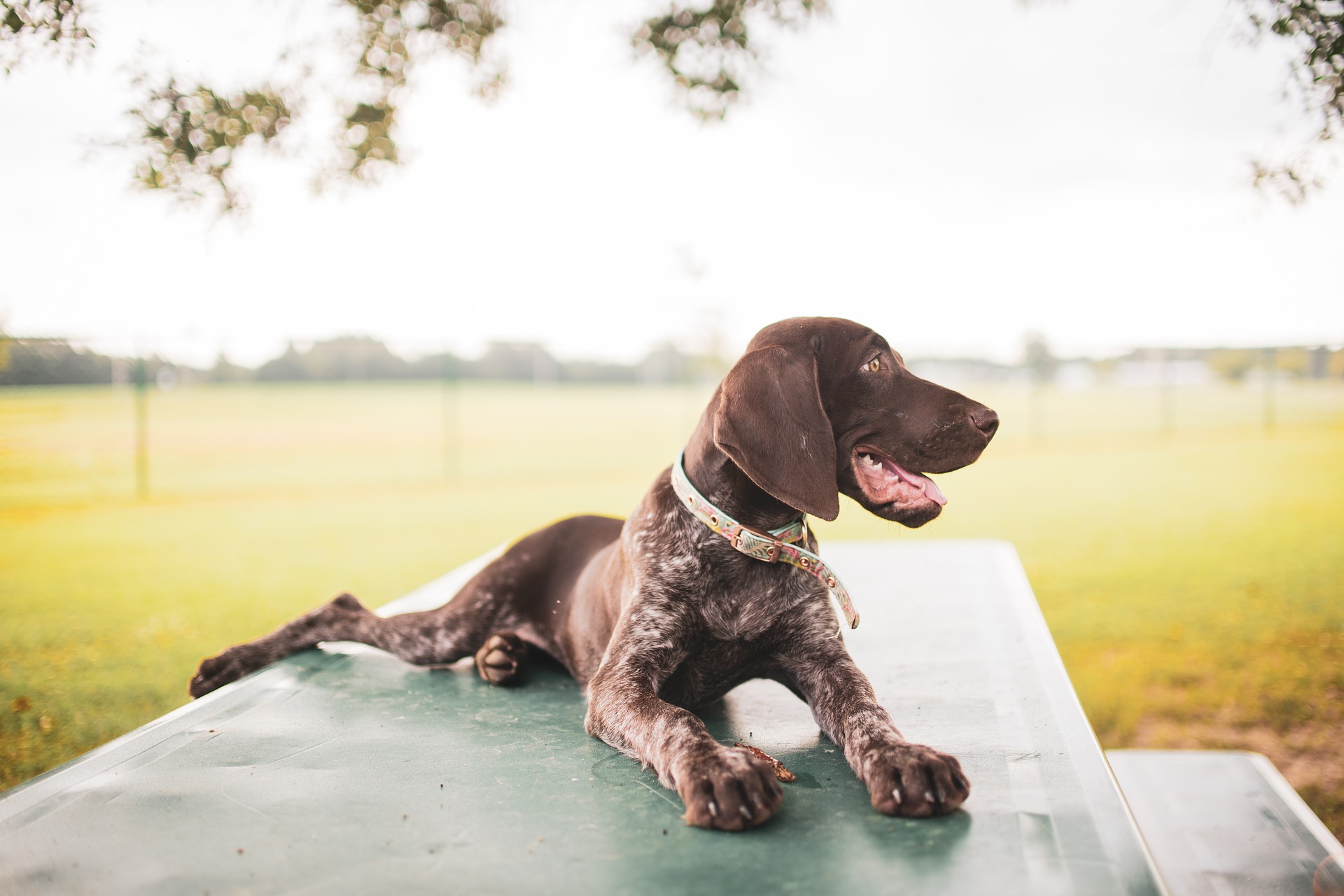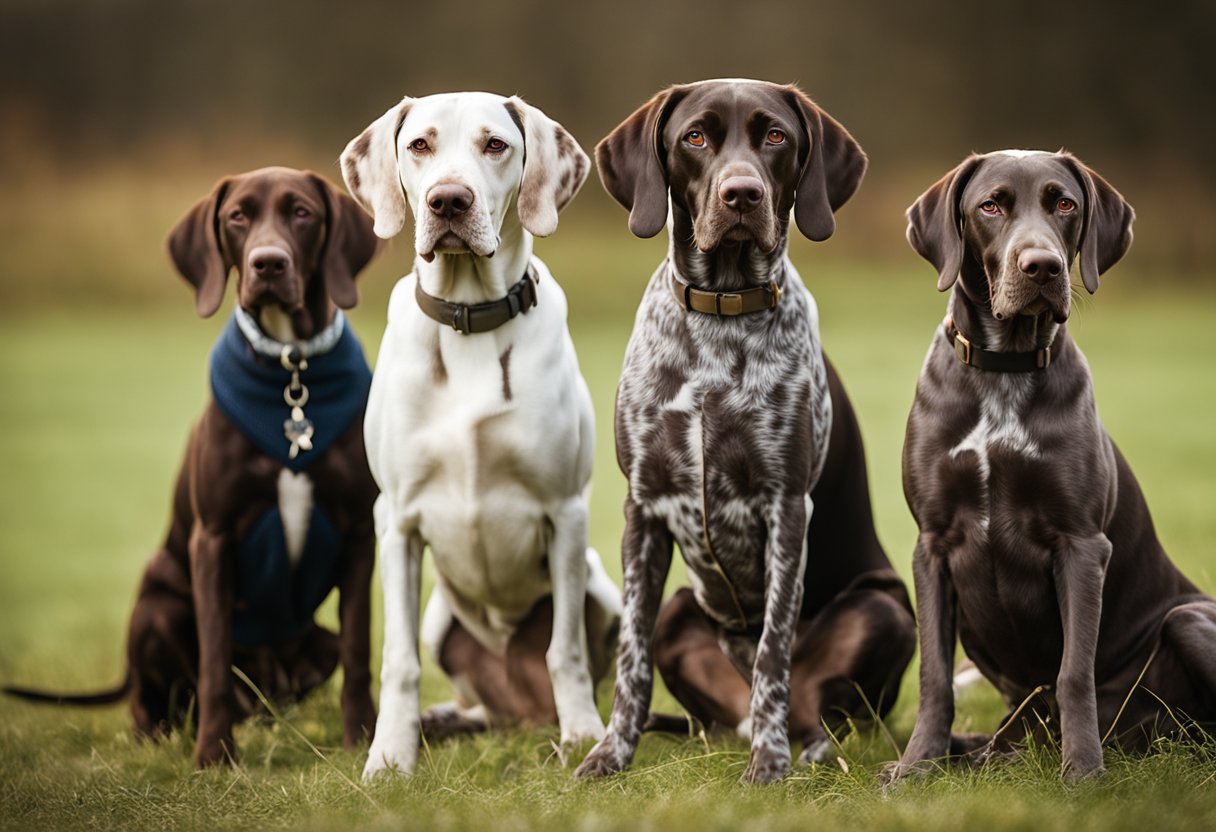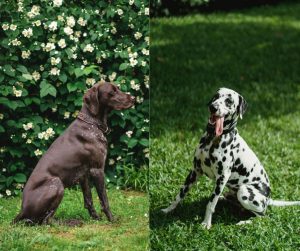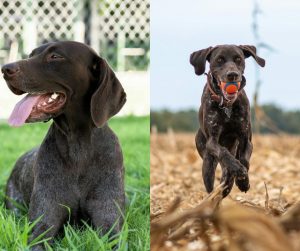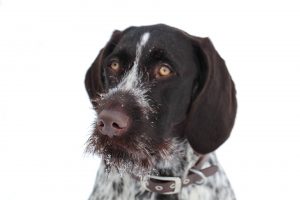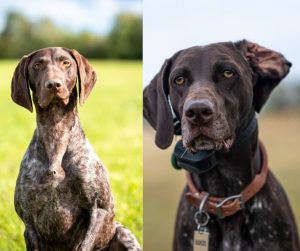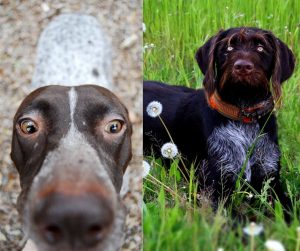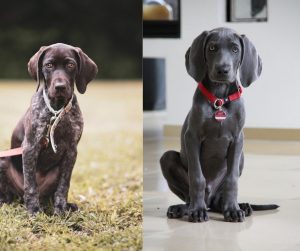The German Shorthaired Pointer is a versatile breed distinguished not only by its hunting prowess but also by its distinctive coat colors and patterns. The breed standard recognizes a solid liver or a combination of liver and white as the primary coat colors, which are both functional and aesthetic, providing camouflage in different terrains. These dogs can display a variety of patterns within these colors, such as ticking, roaning, and patches, which contribute to their unique appearance.
Genetics play a crucial role in determining the coat color of a German Shorthaired Pointer, with liver and black being the base colors. However, the American Kennel Club (AKC) only accepts liver and liver and white variations for registration, considering black an unfavorable deviation from the breed standard. Each German Shorthaired Pointer’s coat is a manifestation of its genetic background and can range from the common liver roan to the rarer solid liver.
Despite the AKC’s position, German Shorthaired Pointers may also possess non-standard colors and patterns that are equally striking, though not officially recognized for show purposes. These include but are not limited to black, white, or a mix of colors that can express in various patterns and shades. Consequently, while coat color can be an important factor for breeders and competitors, for most owners, the dog’s personality and health are usually paramount concerns.
Today, we will explore the world of German Shorthaired pointer colors.
Breed Overview
The German Shorthaired Pointer (GSP) is a breed with its origins in Germany, renowned for its versatility and aptitude in various roles. Recognized by the American Kennel Club (AKC), the GSP is acknowledged as a valuable working dog, favored by hunters and families alike.
Origin: Germany
Recognition: American Kennel Club (AKC)
Breed Group: Sporting
Key Traits:
- Versatile: Excelling in both land and water tasks
- Hunting Dog: Originally bred for hunting, pointing, retrieving
- Family Dog: Friendly and affectionate with family members
- Gun Dog: Skilled in assisting hunters with locating game
- Working Dog: Energetic and adaptable to various working conditions
Popularity:
The GSP is one of the popular dog breeds in the world, prized for its intelligence, energy, and cooperative nature.
Characteristics:
German Shorthaired Pointers are medium-to-large dogs with a distinctive short coat. Their physical build is athletic, capable of enduring long working days in multiple environments.
Coat Colors:
- Liver: A reddish brown hue
- Black: Less common but recognized
- Variations include solid patterns, patches, ticked and roan
This breed exhibits a friendly demeanor, often revealing their enthusiastic and friendly personality through their expressive dark eyes. GSps are suitable for active individuals or families who can provide ample exercise and engagement. They are not just cooperative companions in hunting scenarios but also adaptable to family life, making them a well-rounded breed for various settings.
General Appearance
German Shorthaired Pointers (GSPs) are a breed distinguished by their athletic build and distinctive coat patterns. They exhibit a balance of size and strength, coupled with agility and elegance, which equips them for versatile hunting tasks.
Body and Size
The GSP has a medium to large body size, consistent with their role as active working dogs. They typically weigh between 55 to 70 pounds for males and 45 to 60 pounds for females. Their build is muscular and well-proportioned, reflecting their heritage as efficient hunters.
- Males
- Height: 23 to 25 inches at the shoulder
- Weight: 55 to 70 pounds
- Females
- Height: 21 to 23 inches at the shoulder
- Weight: 45 to 60 pounds
Distinctive Features
This breed is characterized by its smooth contour and a coat that can display a variety of colors and patterns. The coat might be solid or display a mixture of patches, ticking, or roan patterns. Their overall conformation is sturdy with a strong back and a deep chest, essential for endurance in the field.
Tail and Head
Traditionally, the GSP’s tail is docked, though this practice can vary based on country or region. The length is typically around 40% of the original tail, which is done to prevent injury during hunting. The head shows a noble and keen expression, with a broad, arched skull and a sufficiently long muzzle to allow for forceful retrieving. The ears are set high, lying flat and close to the head.
Coat Characteristics
The coat of a German Shorthaired Pointer is distinct not only for its various colors and patterns but also for its easy-to-maintain texture.
Coat Colors and Patterns
The German Shorthaired Pointer colors include an array of coat options including solid liver, solid black, black and white, and liver and white. Moreover, patterns such as patched, ticked, black roan, and liver roan add to the breed’s distinctive appearance.
- Solid Colors:
- Solid liver
- Solid black
- Bi-Colors:
- Black and white
- Liver and white
- Patterns:
- Patched
- Ticked
- Roan
Unique Markings
These pointers may exhibit unique markings, differentiating one dog from another. The ticking on German Shorthaired Pointers appears as small, well-distributed specks, whereas patches are larger areas of solid color.
- Markings:
- Liver patch
- Black patch
- Ticking: can be light or heavy
Texture and Grooming
The breed’s short coat is sleek and feels coarse to the touch, complementing their agile physiques. It requires minimal grooming, making maintenance more manageable for owners. However, the breed still experiences seasonal shedding.
- Coat Texture: Short and sleek
- Grooming Needs:
- Regular brushing
- Bathing as needed
- Minimal compared to long-coated breeds
- Shedding: Seasonal
Coat Color Genetics
The coat color of German Shorthaired Pointers is a direct result of their genetic makeup, with certain genes being responsible for the variety of hues and patterns seen in the breed. These genes determine whether a dog will display colors such as liver, black, or combinations with white.
Genetic Influence on Colors
Genes play a crucial role in the coloration of a German Shorthaired Pointer’s coat. The presence of the liver gene, which is a result of the B locus (Brown locus), can cause the black pigment to be diluted to brown, presenting as the liver color in the breed. Another important gene is at the D locus (Dilute locus), which dilutes the black or liver color to a lighter shade when the recessive variant is present. The Intensity Dilution gene affects the expression of red or yellow pigments, potentially leading to a cream or white coat.
Inheritance Patterns
The inheritance of coat colors in German Shorthaired Pointers follows a Mendelian pattern of dominant and recessive alleles. The dominant alleles typically dictate the prevailing coat color, while recessive alleles may only present visibly if two copies are inherited—one from each parent. A German Shorthaired Pointer with a liver coat color implies that the liver gene is either homozygous dominant or heterozygous, with one liver allele being dominant over a non-liver allele.
- Black (B_) or Liver (bb)
- Dominant Black (BB or Bb)
- Recessive Liver (bb)
- Dilution possible (dd – dilute)
Dogs with a solid black or liver coat carry two copies of a non-dilute dominant allele (DD or Dd), while those with a dilute coat color carry two copies of the recessive dilute allele (dd). The pattern of inheritance dictates that a puppy must inherit specific combinations of these alleles from both parents to express the corresponding coat color or pattern.
Color-Specific Health Considerations
When discussing the German Shorthaired Pointer (GSP), it’s important to consider how coat colors might correlate with certain health issues. While coat color does not directly cause health problems, certain color-specific genes in dogs may be linked to health conditions that can impact their lifestyle and require attention from a veterinarian.
Liver and Black Base Coats:
- These common base colors in GSPs are generally not linked to specific health concerns and are typically robust in terms of coat-related health
White Markings and Patches:
- GSPs with significant white markings may be at a slightly increased risk of deafness. While this is not a certainty, veterinarians might recommend auditory testing for puppies with extensive white areas
Rare Colors (Red, Orange, Lemon, Tan):
- Rare colors may sometimes be associated with a smaller genetic pool, which can lead to a higher chance of inheritable diseases. However, this is not a rule, and many dogs with rare colors are healthy. Veterinarians may suggest genetic testing for rare-colored GSPs to preemptively address potential hereditary conditions
Roan Patterns:
- Roan GSPs are not known to have specific health issues linked to their coat color. However, their lifestyle as working or hunting dogs can necessitate routine checks for skin injuries that may blend with the coat pattern
General Health Considerations:
- All GSPs should undergo regular veterinary checks to monitor their health, regardless of coat color. Common ailments include hip dysplasia and ear infections, which are related more to the breed and lifestyle than to color
In summary, while the GSP’s coat color can have implications for certain health aspects, a veterinarian should evaluate each dog based on its individual health and temperament, rather than treating color as a definitive indicator of health concerns.
Color Prevalence in Breeding
When breeding German Shorthaired Pointers, a breeder places significant emphasis on adhering to color standards. This includes knowing which colors are favored by the American Kennel Club (AKC) and understanding how to maintain the integrity of the breed while selecting for desirable traits.
Reputable Breeding Practices
Reputable breeders prioritize the health, temperament, and breed standard, which encompasses recognized color patterns. Breeders must be aware of the genetic factors that determine coat color to ensure they are breeding in line with the AKC standards. Solid liver and liver and white are prevalent and standard colors. They should be conscious that breeding for color should never supersede the importance of genetic health.
Color Standards and the AKC
The AKC’s breed standard for the German Shorthaired Pointer specifies acceptable colors and patterns, emphasizing the preference for dark brown eyes and penalizing characteristics such as light yellow eyes. The standard allows for colors such as liver, liver and white, and combinations including patched and ticked:
- Solid liver (a deep reddish-brown)
- Liver and white, which can include:
- Liver patched and white
- Liver roan
- Liver and white ticked
While other colors may occur and do not necessarily indicate a dog isn’t purebred, they are not standard and may affect the eligibility of a puppy for show competitions. Breeders aiming to produce show-quality dogs will select mating pairs to promote the breed standard colors.
Lifestyle and Temperament
The German Shorthaired Pointer is a breed characterized by a distinct blend of energy and affection, making them well-adapted for active family life. Their temperament is balanced between a high-spirited nature and a loyal companionship that thrives on interaction and activity.
Energy and Exercise Needs
German Shorthaired Pointers are high-energy dogs that require ample exercise to maintain their health and happiness. They exhibit notable stamina and have a natural inclination towards physical activities.
- Daily exercise requirements: At least 1 to 2 hours
- Exercise forms: Running, hiking, fetching games, swimming
Physical activity not only keeps them fit but also helps to mitigate potentially destructive behaviors that can stem from boredom.
Companionship and Family Life
These dogs are recognized for their friendly personality, making them excellent family dogs. They are known to form strong bonds with their family, showcasing both loyalty and love.
- Family integration: Highly adaptable and fit well into family routines
- Behavior with children: Generally patient and caring
- Behavior with other pets: Can coexist peacefully with proper introduction and socialization
Their intelligent and attentive nature brings joy to households, and they often seek to be an integral part of family activities. However, their hunting heritage means supervision is advisable when around smaller pets.
Training and Activities
The German Shorthaired Pointer thrives when involved in activities that challenge both its body and mind. They are highly intelligent and possess an innate predisposition for hunting and tracking, making them well-suited to various outdoors exercises and dog sports.
Hunting and Tracking
German Shorthaired Pointers are natural hunters with a keen sense of smell and an eagerness to track prey. Their intelligence allows them to navigate and cover different terrains efficiently, which is why they are often trained for hunting expeditions. It’s crucial to provide them with opportunities for scent work, as this stimulates their tracking instincts and channels their energy constructively.
Water Activities and Swimming
These dogs are excellent swimmers, thanks to their webbed feet and water-resistant coat. Integrating water activities into their regimen is a great way to ensure vigorous exercise. German Shorthaired Pointers are adept at water retrieving, and these activities can greatly benefit their muscular development and stamina.
Performance in Dog Sports
Their agility and power translate well in the realm of dog sports. German Shorthaired Pointers excel at events that test their agility and speed, such as flyball or dock diving. Training for these sports improves their coordination and provides the mental and physical stimulation they need. As gun dogs traditionally bred for hunting, they also show remarkable performance in field trials, displaying their skills as the perfect pointer.

